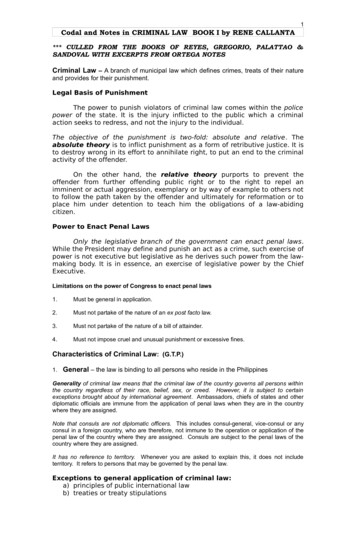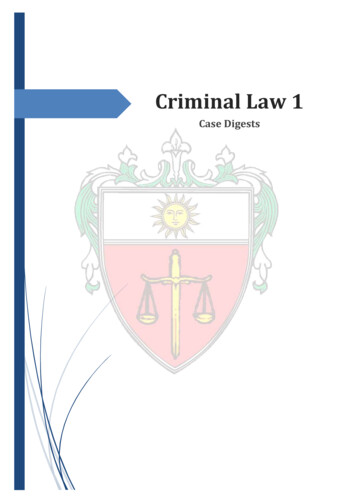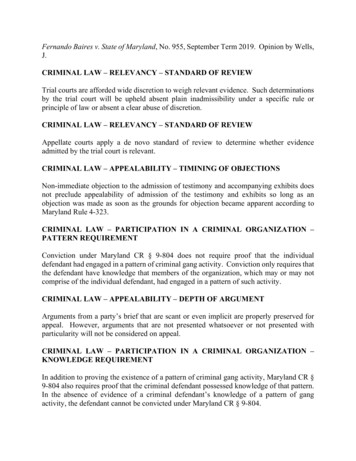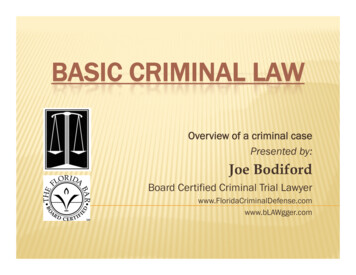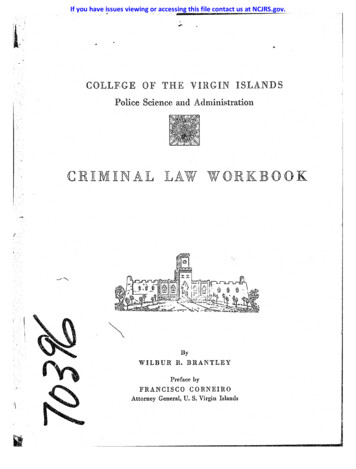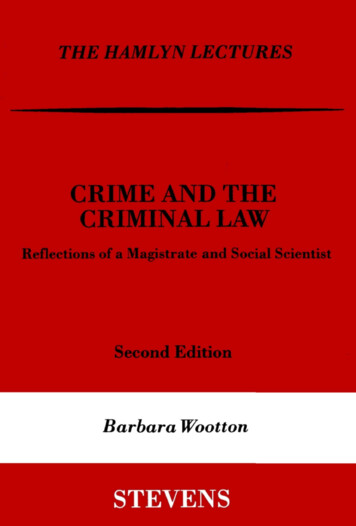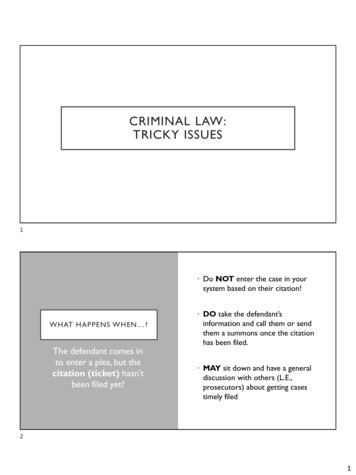
Transcription
CRIMINAL LAW:TRICKY ISSUESWEBINAR: MARCH 12, 2019Amber Myers, Staff Attorney1 Do NOT enter the case in yoursystem based on their citation!WHAT HAPPENS WHEN ?The defendant comes into enter a plea, but thecitation (ticket) hasn’tbeen filed yet? DO take the defendant’sinformation and call them or sendthem a summons once the citationhas been filed. MAY sit down and have a generaldiscussion with others (L.E.,prosecutors) about getting casestimely filed21
WHY NOT JUST TAKE THE CITATION? After all, the defendant is here and wants to dispose of it now. If we sendthem away, they may never come back. Isn’t it a win-win to just scan theirticket into our system and take the plea and payment? No. In many cases the ticket was actually sent to another court. So thedefendant assumes it has been taken care of since they paid you, and thengets arrested when they ignore notices from the other court of thepending case.3WHAT IF THEY MAIL IN PAYMENT AND WEHAVE NO CITATION? Remember that normally mailing in payment in full is considered a plea ofnolo (no contest). But, if you don’t have a charging instrument (citationor complaint), you don’t have a case. So there isn’t anything for thedefendant to enter a plea to. You don’t have jurisdiction, and therefore you have no authority toact.42
WHAT IF THEY MAIL IN PAYMENT AND WEHAVE NO CITATION? If you receive a mailed payment for a case that hasn’t been filed, youshould immediately notify the prosecutor. If the prosecutor can quicklyget the case filed, you can apply the payment to the case, and enter theplea of nolo. If they cannot get it filed quickly, you should mail the paymentback. It is an auditing nightmare to hold money in your court without acase that it goes to.5WHAT HAPPENS WHEN ?An electronic copy of acitation is filed?63
ELECTRONIC CITATIONS If a defendant is released on a citation, a duplicate copy of the citationmust be filed with the court, and that duplicate copy serves as a complaintto which the defendant may enter a plea. Code of Criminal Procedure Art. 27.14(b) That duplicate copy can be an electronic copy.7ELECTRONIC CITATIONS However, often what the court receives electronically is not a duplicatecopy of the citation, but instead is just data that is uploaded from thecitation. These electronic “data dumps” from the Automatic Ticket Downloaderare not duplicate copies, and so are not charging instruments that giveyour court jurisdiction over a case.84
WHAT HAPPENS WHEN ?The case isn’t filed in theright court?9JURISDICTION If a court doesn’t have jurisdiction, the case must be dismissed. So if a criminal case that is not a fine-only misdemeanor, for exampleaggravated assault, is filed in your court, you would issue an orderdismissing the case. If you do not have jurisdiction, you do not need to wait for a party tobring this issue up or ask you to dismiss it, you dismiss it on your own.105
VENUE If it isn’t the type of case that is the problem, but instead the locationwhere it was filed, the problem is not jurisdiction, it is venue. In other words, the court may hear the type of case (fine-only misdemeanor), but itis filed in the wrong location. You do not dismiss cases for being filed in the wrong venue, but thedefendant may ask for the case to be transferred to the correct court.11VENUE – MOTION TO TRANSFER If a case is filed in the wrong court, the defendant can make a motion totransfer venue, in which case your court should transfer it to theproper court. A motion is a request from a party for the court to do something. Additionally, many counties have administrative transfer rules, which ofteninclude a rule which requires an automatic transfer if the case is filed inthe wrong court. Code of Criminal Procedure Art. 4.12(e)126
VENUE – RIGHT COUNTY So what is the right venue? The prosecutor must prove at trial by a preponderance of theevidence (meaning it is more likely than not) that the offense occurred inthe county it is being tried in Code of Criminal Procedure Art. 13.17 Remember that for every other element in a criminal case, the standard isbeyond a reasonable doubt! It is only venue that has a preponderanceof the evidence standard.13VENUE – RIGHT PRECINCT In addition to the right county, the Code of Criminal Procedure listswhich precinct in that county a justice court criminal case should be triedin: The precinct the offense occurred in; The precinct the defendant lives in; or Any other precinct in the county by written agreement of the prosecutor anddefendant. Code of Criminal Procedure Art. 4.12147
WHAT IF THE DEFENDANT DOESN’T MAKE AMOTION TO TRANSFER VENUE? If venue is incorrect, and the defendant doesn’t make a motion to transfer,and your county doesn’t have rules of transfer which require a transfer: If the case is filed in the wrong precinct, proceed with the case as you normallywould. If the case is filed in the wrong county, the defendant must be found not guilty attrial, since one thing the state must prove is that the offense occurred in the countythat it is being prosecuted in.15OFFICERS CONSISTENTLY FILING INIMPROPER VENUE From time to time, counties face issues of cases deliberately being filed inthe wrong court for various reasons. The best way to address this issue is by having a sit-down meeting with allthe involved stakeholders. If that is insufficient, the county should adoptadministrative transfer rules providing for automatic transfer when thevenue rules are not being followed.168
“IMPROPER FILING” COMPARISONJURISDICTION ISSUEVENUE ISSUE Wrong kind of case Wrong location Court dismissesautomatically. Court transfers if thedefendant makes the requestor if your county has transferrules telling you to transfer. If you don’t dismiss the case, ajudgment convicting thedefendant would be void(worthless and unenforceable). If filed in wrong county,defendant must be found notguilty at trial.17WHAT HAPPENS WHEN ?The officer mailed thecitation to thedefendant?189
MAILED CITATIONS The most common situation where this occurs is when the defendant isinjured in an accident and taken to the hospital. Law enforcement decidesto charge the defendant with an offense, and mails them a citation. Instead of mailing a citation, proper procedure would be for the officer to file acomplaint. One problem is that the defendant never signed the citation promising toappear, and may not know when to appear. The court should mail thisdefendant a summons to appear.19WHAT HAPPENS WHEN ?The case is outside ofthe statute oflimitations?2010
STATUTE OF LIMITATIONS A statute of limitations is a law limiting how long after somethingoccurs a civil or criminal case can be filed. Misdemeanor criminal cases must be filed within 2 years of the date ofthe offense. Code of Criminal Procedure Art. 12.0221STATUTE OF LIMITATIONS A sworn complaint stops the statute of limitations from running out. The legal term for this is that the complaint tolls the statute of limitations. However, a citation (ticket) does not! Many cases ended up withouthaving complaints filed, and the statute of limitations ran out, costingcounties millions of dollars in revenue.2211
STATUTE OF LIMITATIONS This caused a change in the law where now a complaint must be filed ifthe defendant pleads not guilty, or doesn’t appear by their appearancedate! Code of Criminal Procedure Arts. 12.05, 27.14(d) This complaint should be filed by police or prosecutors. Since filing thecomplaint tolls the statute of limitations, it directly benefits the state. Thecourt should not take actions designed to benefit one side over theother.23WHAT IF THE STATUTE OF LIMITATIONSRUNS OUT? It is unethical for a prosecutor to continue to prosecute a case after thestatute of limitations. It is unethical for a court to continue to pursue a case after the statute oflimitations runs out. Remember that this does not apply to cases where the defendant has beenconvicted! The prosecutor should file a motion to dismiss if the statute of limitationshas run out.2412
WHAT HAPPENS WHEN ?A private citizen wantsto file a complaint? DO recommend that they speakwith law enforcement or aprosecutor. DO NOT refuse to accept thefiling if they insist. DO evaluate a filed complaint forprobable cause on each element ofthe offense. DO issue a summons for thedefendant if the offense is properlyalleged. DO set the case for pretrialhearing so that the prosecutor canelect how to proceed.25WHAT HAPPENS WHEN ?A defective complaint isfiled?2613
DEFECTIVE COMPLAINTS There are two ways a complaint could be defective – failure to state anoffense or defective in form or substance. If a complaint fails to state an offense, the court should take no action,since no case has actually been filed. If the complaint is defective in some other fashion, it is up to thedefendant to raise the issue.27DEFECTIVE COMPLAINTS Complaints from private citizens frequently fail to state an offense. Forexample, they may file a complaint that the other person is saying meanthings about them on Facebook. The court should inform the person filing the complaint that nothing will occur.2814
MOTION TO QUASH A defendant is entitled to notice of the complaint no later than the day beforeany hearing in the case (such as a trial or pretrial hearing). The defendant maywaive (give up) the right to notice. Code of Criminal Procedure Art. 45.018(b) The defendant must make an objection to the complaint before the day oftrial, or they have waived it. Code of Criminal Procedure Art. 45.019(f)29MOTION TO QUASH The way the defendant objects to a defective complaint is by filing amotion to quash the complaint. This means they want the complaint quashed, meaning they want it dismissed. If this motion is filed, and you agree that the complaint is defective, youenter an order quashing the complaint. Law enforcement or the prosecutor could then re-file a proper complaint.3015
MOTION TO QUASH This procedure is another good example of why court clerks should notbe generating and filing complaints. If I am a defendant and I file a motion to quash, and I know you are going to be rulingon your employee’s complaint, should I expect a fair and neutral ruling?31WHAT HAPPENS WHEN ?The defendant doesn’tappear by theirappearance date?3216
TOOLS IN THE TOOLBOX There are many tools available to a court to secure a defendant’sappearance when they fail to appear and enter a plea by their appearancedate. For a full and detailed explanation of these options, see Chapter 3 of theCriminal Procedure Deskbook, including the flowchart. For most courts, the first step is a courtesy letter, which reminds thedefendant of their obligation and sets a new “appearance date.”33NEW CRIMINAL CHARGE Frequently, not showing up by their appearance date will constitute a newcriminal charge of either Failure to Appear (FTA) or ViolatePromise to Appear (VPTA). Complaints alleging these offenses should be filed by law enforcement orprosecutors. These new offenses must be processed the same as any other new offense, nottreated as “late fees” or “penalties” tacked on to the original case.3417
FTA VS. VPTAFTAVPTA Penal Code Sec. 38.10 Transportation Code Sec. 543.009 Defendant released from custody oncondition that they subsequently appear(bond or sign citation). Defendant charged with Rules of theRoad offense signs citation promising toappear. Defendant intentionally fails to appear aspromised. Defendant willfully violates that promise. 1-200 fine range Class C ( 1-500 fine)35FTA & VPTA What is a Rules of the Road offense? Offense under Chapters 541-600 of the Transportation Code What if both FTA/VPTA seem appropriate? must charge VPTA; Azeez v. State For purposes of FTA, a defendant is “in custody” when they have beendetained by a peace officer, even if they are issued a citation rather thanbeing booked into jail. See Ch. 3, Sec. C, Part 4 of Criminal Deskbook for more3618
ISSUANCE OF ARREST WARRANT The court is authorized to issue an arrest warrant, which is an orderfor law enforcement to go pick the defendant up and bring them to court. Code of Criminal Procedure Art. 45.014(b)(3) However, there are several safeguards that must be followed to ensurethat the defendant’s rights are not violated.37ISSUANCE OF ARREST WARRANT An arrest warrant may not issue solely based on the filing of a citationor “ticket” in justice court. A sworn complaint, alleging either the originaloffense (sometimes called the underlying offense) or a new offense ofFTA or VPTA must be filed before a warrant or capias may be issued. A capias is an order, very similar to a warrant, ordering a law enforcement officerto bring the defendant directly to the court. This is different than a capias pro fine,which is the order to bring a defendant who has been convicted but notsatisfied the judgment, to court to determine how the judgment may be satisfied.3819
ISSUANCE OF ARREST WARRANT An arrest warrant based on the defendant’s failure to appear(whether the warrant is for the original offense, FTA, or VPTA) may notissue until the court has given a notice by mail or telephone providing: A date and time when the defendant must appear before the justice or judge; The name and address of the court with jurisdiction in the case; Information regarding alternatives to the full payment of any fine or costs owed bythe defendant, if the defendant is unable to pay that amount; and An explanation of the consequences if the defendant fails to appear before thejustice or judge as required. Code of Criminal Procedure Art. 45.014(e)39REFERRAL TO COLLECTIONS/OMNI Remember that we earlier discussed referring defendants who do notsatisfy the judgment to collections and/or to Omni. Collections – outside entities that attempt to get the defendant to appear or tosatisfy a judgment. Omni – company with a contract with DPS; defendants in Omni c
Criminal Procedure Deskbook, including the flowchart. For most courts, the first step is a courtesy letter, which reminds the defendant of their obligation and sets a new “appearance date.” NEW CRIMINAL CHARGE Frequently, not showing up by their appearance date will constitute a new


